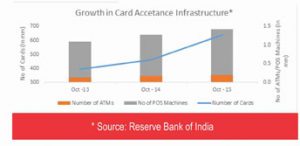
As the world is on a transition path to espouse a cashless economy, a developing economy like India and its other peers in South East Asia are still playing the catch up game to reach that transition phase. Compared to advanced economies like the US and other European Countries, India is still depending heavily on cash based transactions.
The Reserve Bank of India (RBI) which is the central bank of the country has taken many initiatives to undertake this behemoth task of transforming India into a cashless economy. RBI also floated a concept paper on policy framework for expansion of card acceptance infrastructure in the country and asked for feedback from the public. The paper outlines the broad contours of a multi-pronged strategy to enhance the growth in acceptance infrastructure and usage of cards including further rationalisation of merchant discount rates (MDR) or merchant fees for debit card transactions.

The Government of India has been promoting Financial Inclusion in an enormous way. Under the Prime Minister Jan Dhan Yojana programme (PMJDY), the card issuance under RuPay network has seen a tremendous growth in a short span of time. However, most of the debit cards issued where inactive because of lack of card acceptance infrastructure like ATMs and POS machines. The trend in card issuance and increase in payments infrastructure in given below. (Statistics published by RBI)
The trend clearly indicates that the Card Acceptance Infrastructure has not kept pace with the growth in number of cards.
RBI has proposed the following Strategies for enhancing acceptance of Cards
Mandate installations of POS terminals in proportion to cards issued: The RBI said that banks issuing cards should install proportionate number of POS terminals to the number of cards issued. However, it noted that not every bank is equipped to run merchant acquisition business. The lack of expertise may lead to some banks entering this business through outsourcing model which later might prove costly.
Image removed by sender. Image * Source: Reserve Bank of India
Setting up of Acceptance Development Fund (ADFs): The RBI also mooted for setting up an ADF where different stakeholders in the card payment chain come together to set up a program to encourage wider deployment of card acceptance infrastructure. These are generally funded by card issuers to build a corpus by diverting a percentage of their transaction revenue into the fund which is then invested in structured initiatives to expand acceptance infrastructure.
ADFs are usually managed by third parties who establish the framework for use of funds which include subsidies for installation of terminals, development of new technologies / segments / geographies, marketing and education to increase awareness for acceptance as well as for usage.
Rationalisation of Merchant Discount Rate
The major source of revenue in the card business is the Merchant Discount Rate (MDR) or Merchant Service Fee. MDR comprises other cost segments such as the interchange fee (fee paid by acquirer to card issuing bank), processing and other fees payable to the card network, and other costs incurred by the acquirer along with acquirer’s margin. The RBI has proposed a number of options for the rationalization of the MDR some of them are:
Uniform MDR across all merchant categories & locations proportionate to transactions size: RBI had fixed a cap on MDR for debit card usage as
• Not exceeding 0.75% of the transaction amount for value upto Rs. 2000/-
• Not exceeding 1% for transaction amount for value above Rs. 2000/-
This is basically maintaining status quo for the regulatory structure. However, the growth in deployment of POS terminals has come down as lower MDR was cited as on of the reasons making the business unviable.
Image removed by sender.
Differentiated MDR at select merchant categories at all locations: Another approach is to have a differentiated MDR framework for some select merchant categories across all locations. For example, some merchant categories could include utility bill payments (electricity, water, gas, telephone), municipal taxes, primary hospitals and health centres, primary educational institutions, public distribution system outlets (like ration shops), fertilizers, seeds and similar agricultural products, public transport, etc.
Differentiated MDR at select merchant categories in Tier III to VI locations: An another alternative is to rationalise MDR in select categories in Tier III to VI locations with the objective of ensuring wider deployment of POS terminals.
The concept paper details the perceived pros and cons of each of the strategy in great detail and has asked for feedback from the public.
The link to the concept paper is given below.
https://rbidocs.rbi.org.in/rdocs/PressRelease/PDFs/PR2110BE5B89DE283145DA8AF0B26881F82BAC.PDF


